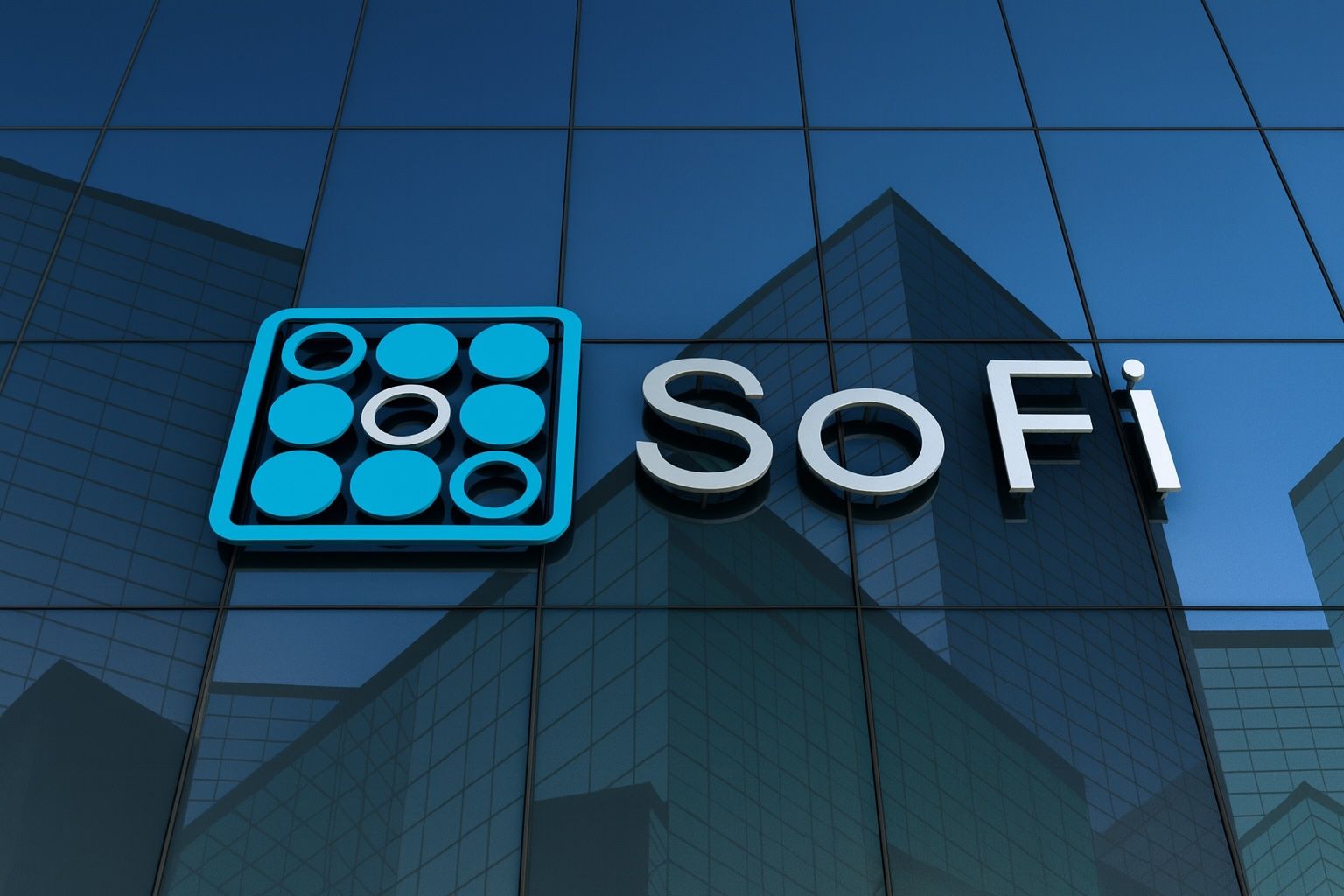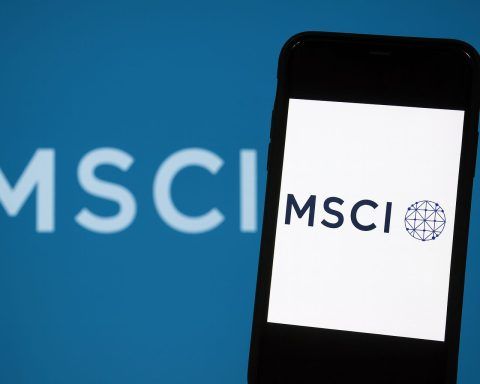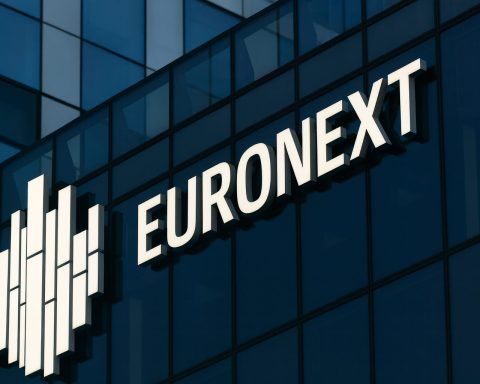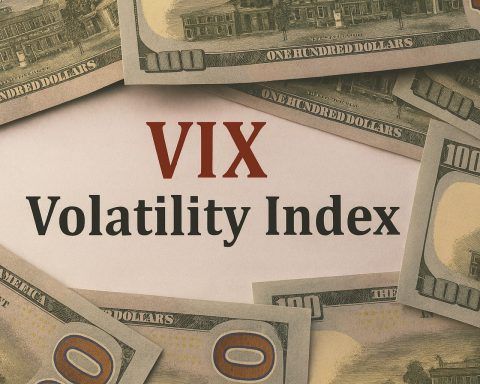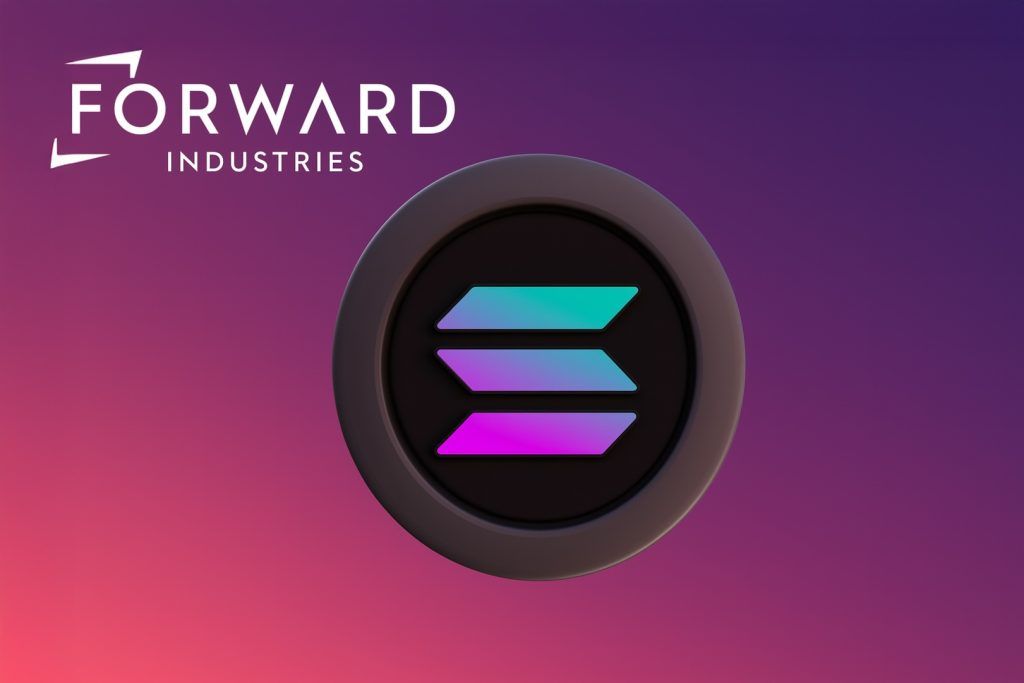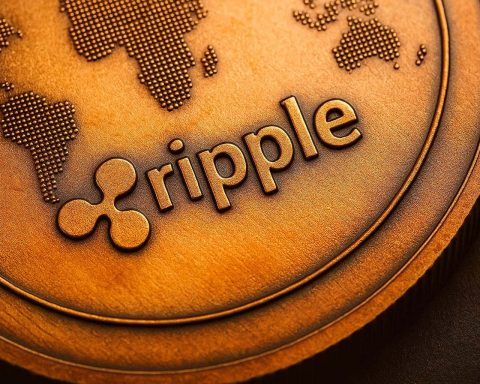- Spectacular 2025 rally: SoFi Technologies (NASDAQ: SOFI) stock has soared over 220% year-over-year as of early October 2025 [1] – quadrupling over three years – far outpacing the S&P 500’s ~16% gain [2]. Shares recently hit a 52-week high of $30.30 (52-week low was ~$8.16) [3] before a pullback.
- Recent pullback & technicals: After eight straight weekly gains, SOFI saw a multi-day slide in late September/early October [4] [5]. The stock dipped ~10% in the first week of October amid profit-taking and analyst downgrades, testing support at its 10-week moving average [6]. It closed around $25–26 per share on Oct 6 [7], still up ~70% year-to-date [8]. Volatility is elevated (beta ~1.9) [9], reflecting its high-growth nature.
- Blowout growth & financial momentum: SoFi has posted seven consecutive profitable quarters [10], with Q2 2025 revenue up 44% year-on-year and record loan originations [11]. Trailing 12-month revenue stands around $3.0 B with net income ~$562 M (EPS ~$0.49) [12]. The company’s member base swelled to 11.7 million (≈34% YoY growth) [13], and total products to 17.1 M, as SoFi’s “financial super-app” cross-sells multiple services per user.
- Major product launches: In October, SoFi launched no-fee options trading for beginners – “Level 1” options (covered calls, cash-secured puts) – with zero commissions or contract fees [14] [15]. The move came in response to customer demand and brings SoFi in line with brokers like Schwab on basic options access. CEO Anthony Noto said the feature, with built-in education, lets members “diversify their strategies…with confidence” [16]. SoFi plans to add more advanced options, options in IRAs, and even same-day (0DTE) contracts soon [17].
- Crypto & fintech innovation: The fintech is doubling down on crypto and blockchain. By late 2025, SoFi aims to relaunch crypto trading (after a regulatory pause) and even introduce its own stablecoin for payments [18]. Management confirmed plans to let members send global remittances via blockchain (through a partnership with Lightspark) and to offer crypto custody and stablecoin reserves now that regulators have opened the door [19] [20]. SoFi also rolled out a new AI-focused ETF in 2025 [21] as it expands product offerings.
- Competitors & market position: SoFi’s one-stop-shop model – spanning lending, banking, investing, and tech infrastructure – sets it apart from fintech rivals. Unlike Robinhood or Chime which focus on trading or neobanking alone, SoFi combines multiple services under one roof [22] (including its Galileo platform powering 160M+ accounts for partners [23]). This integrated ecosystem has driven cross-selling (35% of new products go to existing members) [24] and helped SoFi’s stock leap ahead of peers in 2025. For context, online lender LendingClub trades at ~23× earnings, while Affirm (BNPL) remains unprofitable [25] – SoFi, with a forward P/E ~35–60 (depending on 2025 estimates), commands a premium for its growth [26] [27].
- Analyst sentiment split: Wall Street is divided on SOFI. Morgan Stanley and Compass Point issued double-downgrades to “Sell” in late September, arguing the ~250% 1-year rally left valuation “overextended” [28] [29]. Morgan Stanley’s $18 price target implies ~30% downside [30], and Compass Point’s $12 target even more [31]. In contrast, Mizuho has a Street-high $31 target [32], seeing significant upside in SoFi’s long-term expansion. The consensus analyst rating is “Hold” with an average target around $20–$23 [33] – below the current market price, reflecting valuation concerns. Bulls like Jefferies (Buy) highlight SoFi’s explosive growth and 25%+ revenue CAGR guidance, while bears warn its ~9.5× sales and ~4.5× book multiples are steep if growth falters [34] [35].
- Market and social buzz: Retail investor enthusiasm for SoFi is running high. Social media sentiment scores ~81/100 (82nd percentile), indicating predominantly bullish chatter on forums like Reddit [36]. The stock is frequently discussed in fintech investing communities as a potential long-term winner. Short-sellers have pulled back – short interest is down to ~9% of float (≈1.5 days to cover) [37], a sign that many skeptics have covered positions as SoFi proved profitability. Still, at a ~$30B market cap [38], SoFi’s valuation leaves little room for error, so any hiccup could spark volatility.
- Looking ahead:Q3 2025 earnings are due on Oct 28 [39], and could be a catalyst. Analysts expect continued strong growth (Seaport Research projects FY2025 EPS of ~$0.31 [40]) and will watch margins as deposit costs and marketing spend rise. SoFi’s management remains optimistic – they raised full-year guidance and target ~$3.37B revenue (+30% YoY) and ~$960M adj. EBITDA in 2025 [41]. They’re even aiming for $0.55–$0.80 EPS by 2026 with 25%+ annual revenue growth [42]. If those goals are met, today’s valuation could be justified, and some experts see “healthy upside by the end of the decade” for SOFI stock [43]. However, risks like fluctuating interest rates, credit quality in a possible recession, and regulatory hurdles (e.g. student loan policies) remain in play [44] [45]. Overall, SoFi has emerged as a fintech leader in 2025, and investors are keenly watching whether it can maintain its breakneck growth and momentum into 2026 and beyond.
Stock Performance & Technical Trends (2025 Rally & Pullback)
SoFi’s stock has been on a tear in 2025, massively outperforming the broader market. From October 2024 to October 2025, SOFI shares rocketed roughly +260% [46], versus about +16% for the S&P 500 in that period. Over the last year alone the stock is up 233% [47], reflecting investors’ enthusiasm as SoFi turned consistently profitable and expanded revenue streams. In fact, the stock has quadrupled since 2022, delivering about 400% gains over three years [48] as the company rapidly grew its customer base and financial results.
That red-hot momentum led to overbought technical conditions by late September 2025. SOFI had risen in eight consecutive weeks at one point [49], and by late September it peaked at a 52-week high of $30.30 [50] per share. Some consolidation followed: going into October, shares pulled back roughly 10% from their highs amid broader market volatility and profit-taking. Notably, SoFi declined for seven sessions in a row to start October [51] – a modest correction after its parabolic run-up. This dip brought the price down into the mid-$20s (the stock closed at $26.36 on Oct 6, 2025 [52]).
From a technical analysis standpoint, the retracement brought SOFI back toward its 10-week moving average, a key support level that often acts as a floor during strong uptrends [53]. Indeed, Investor’s Business Daily noted that by October 2, the stock was “testing its 10-week moving average” – potentially offering a buying opportunity after a 145% surge year-to-date [54] [55]. Despite the recent dip, the overall trend remains bullish, with SoFi still up roughly 68–72% in 2025 year-to-date [56] [57]. The stock’s beta ~1.9 underscores its above-average volatility [58], so investors should expect continued swings. Short-term momentum has cooled from extreme levels (the relative strength index briefly pulled back from overbought territory), but SoFi remains in a long-term uptrend fueled by its improving fundamentals.
It’s also worth noting the trading activity and liquidity behind SoFi’s run. The stock has been among the most actively traded on the Nasdaq – for instance, on Oct 1, over 80 million shares exchanged hands [59] (compared to ~1.2 billion shares outstanding). This high turnover suggests significant retail trader interest and institutional activity. SoFi’s market capitalization is about $30–31 billion as of early October [60]. For context, that’s larger than many mid-sized banks, reflecting the market’s growth expectations for SoFi. The 52-week range ($7.57 – $30.30 [61]) shows just how dramatically sentiment shifted over the past year – from multi-year lows in late 2024 to new highs by late 2025.
Key technical indicators: By Oct 7, SoFi hovered around the mid-$20s, roughly 15% below its peak. Its 50-day moving average was trending upward in the low $20s, and the 200-day MA in the mid-teens (reflecting the prior year’s lower prices). The stock’s relative strength vs. the market remained high despite the pullback – it has been among the year’s top growth stock performers. Traders are watching if the 10-week line holds as support; historically, during strong rallies, SOFI has often rebounded off that level. A break below might signal a deeper correction, whereas a bounce could attract “buy the dip” investors. Overall, technicals show bullish momentum moderating to healthier levels after a euphoric rise – a natural breather that many analysts expected given the stock’s rapid ascent [62] [63].
Recent News (Early October 2025): Earnings Buzz and Downgrades
In the days leading up to October 7, 2025, SoFi was a headline fixture, with several notable developments:
- Q3 Earnings Date & Guidance: SoFi announced it will report third-quarter 2025 results on October 28, 2025 [64], accompanied by a conference call that morning. Anticipation is high, as investors are eager to see if SoFi can extend its streak of earnings beats. In Q2 2025, SoFi delivered $0.08 EPS (vs. $0.06 expected) [65], its 7th consecutive quarterly profit, and raised full-year guidance. Management now projects FY2025 adjusted net revenue around $3.37 B (≈30% YoY growth) and adj. EBITDA near $960 M [66] – numbers that underscore SoFi’s accelerating scale. Analysts will watch Q3’s metrics on member growth (which was +34% YoY in Q2, hitting 11.7M members [67]) and product cross-selling, as well as net interest margin trends. The upcoming earnings are seen as a potential catalyst for the stock’s next move, per a Seeking Alpha preview that argued strong Q3 results “could ignite further rally” into 2026 [68].
- Analyst Downgrades Trigger Pullback: Toward the end of September and into early October, two prominent Wall Street firms issued sell ratings on SOFI, cooling some of the stock’s euphoria. Morgan Stanley downgraded SoFi to Underweight (equivalent to Sell) on valuation concerns, even as it raised its price target to $18 [69] (from around $16 prior). MS cautioned that after a ~250% 1-year surge, SoFi’s stock price had likely run ahead of fundamentals and could be vulnerable if macro conditions change [70]. Around the same time, Compass Point also cut the stock to Sell with an even lower $12 target [71]. These double downgrades – described as one of the “deepest ironies” of Wall Street (success breeding skepticism) [72] – helped spur a selloff. SoFi’s stock fell about 5.5% on Sept 30 [73] and continued sliding into the first week of October as these cautious calls gained attention. As one analyst quipped, after a parabolic run, “most buyers are already in,” leaving SoFi vulnerable to any disappointment [74]. The liquidity-driven rally had made the stock pricey, with SoFi trading near 10× trailing sales vs. ~3× a year ago [75]. Thus, some profit-taking was natural.
- “Fintech Rocket Starting to Cool?” – TechSpace 2.0 (ts2.tech) ran a detailed stock report on Oct 1, 2025 titled “Is the Fintech Rocket Starting to Cool?” [76]. It noted SoFi’s multi-day slide in late September, heavy trading volume, and highlighted mixed financial signals: booming revenue but also rising costs. An analysis cited in the report (from AInvest) pointed out SoFi’s customer acquisition cost (CAC) rose to ~$284 per new member and that SoFi carries $3.94 B in debt [77]. It also mentioned potential regulatory headwinds (e.g. uncertainty around student loan forgiveness programs that could affect refinancing demand) [78]. In sum, while SoFi’s growth is undeniable, the report echoed that valuation and execution risks are on investors’ minds after such a steep run-up. Notably, ts2.tech reported SoFi’s trailing P/E around 52 and forward P/E over 60 [79], indicating a lot of future growth is already priced in. This context likely contributed to the stock’s recent profit-taking phase.
Despite the cautious tone of some news, other outlets remained upbeat. For example, Investor’s Business Daily ran a piece on Oct 2 highlighting SoFi as a “Fintech Leader,” noting its 145% surge as earnings growth accelerates and suggesting the recent dip toward the 10-week average could be a buying opportunity [80]. Around the same time, The Motley Fool published multiple articles (many also syndicated on Yahoo Finance) discussing whether SoFi is still a buy after the pullback. One Fool analyst (Parkev Tatevosian) actually downgraded his stance after the 2025 run, citing concerns that the valuation had become “too rich” even though SoFi remains a long-term winner in his view [81] [82]. Another Fool contributor, however, argued that SoFi could “set you up for life” if bought now, praising its expanding customer base and 4X share price gain since 2020 [83].
In summary, the recent news cycle has been a tale of two narratives: one of short-term caution (profit-taking, downgrades, high valuation metrics) and one of long-term optimism (strong growth, upcoming catalysts like earnings, and new products rolling out). This push-pull is typical for a high-growth stock like SoFi that has rallied so far, so fast. As we move past the early-October digestion of those downgrades, the focus is now shifting to SoFi’s execution in Q3 and beyond to justify its lofty stock price.
Company Financials and Developments: Results, Strategy, Leadership
Financial performance: SoFi’s fundamental performance in 2025 has underpinned its stock surge. The company has transformed from a high-growth but unprofitable fintech into a firm now delivering consistent earnings. It surprised many by achieving GAAP profitability for the first time in late 2024, and it has remained in the black each quarter since [84]. Over the last 12 months, SoFi generated about $3.03 billion in revenue against $561.6 million in net income [85] – a stark turnaround from net losses just two years prior. This puts its net profit margin around 18.5% over the past year, although on an adjusted basis (excluding one-time items) margins are a bit lower. In Q2 2025 alone, SoFi had net income of $97.3 M (11% margin) [86], signaling that scale efficiencies are kicking in. Return on equity is still modest (~6.5% ROE [87]) as SoFi continues to invest heavily in growth, but the trend is upward.
Revenue mix and growth drivers: SoFi’s top-line growth remains explosive. In Q2 2025, revenue climbed 44% YoY to $858M [88], and management raised full-year 2025 revenue guidance to ~$3.37B (about +30% YoY) [89]. Impressively, SoFi’s growth is increasingly balanced across segments. Its original core business – lending – is still strong (Q2 loan originations hit a record $8.8B, +64% YoY [90], driven by personal loans), but non-lending streams now comprise 47% of net revenue [91]. This includes financial services (checking/savings accounts with interchange fees, credit cards, brokerage, etc.) and technology platform revenue. The latter comes from SoFi’s Galileo and Technisys units, which provide API and core banking solutions to other fintechs and banks. Galileo, acquired in 2020, has been a quiet growth engine: it powers over 160 million accounts globally for various partners [92]. This platform revenue is largely fee-based and higher-margin, helping boost SoFi’s overall gross margin.
Crucially, SoFi’s strategy of being a “one-stop shop” financial platform is yielding cross-selling benefits. The company added 850,000 new members in Q2 (bringing total members to 11.7 million), a +34% increase year-over-year [93]. But product growth was even higher: SoFi added 1.26 million new products in the quarter (total products 17.1M, also +34% YoY) [94]. The fact that products are growing in line with members implies each customer on average is using more SoFi offerings. Indeed, SoFi noted about 35% of new products are adopted by existing members [95] – evidence of deepening wallet share. For example, someone might start with a student loan refinance, then open a SoFi bank account for direct deposit (enticed by a high APY), then start investing through SoFi Invest, etc. This lifetime value expansion per customer is key to SoFi’s long-term profitability aims.
Business strategy and model: SoFi’s mission is to leverage this all-in-one model to drive operating leverage. By bundling services, it can acquire customers once but monetize them across multiple products – theoretically reducing the marginal customer acquisition cost for each new product. (However, ts2.tech’s analysis did flag that overall CAC per member is about $284 [96], which is significant – reflecting heavy marketing spend to gain share). The company’s marketing expense (over $700M in 2023 [97]) has been high, but management defends it as necessary fuel for growth and building the brand. As SoFi’s user base and deposits grow, it can rely less on external funding and more on its own banking subsidiary (SoFi Bank, N.A.) to fund loans at low cost. Since obtaining a national bank charter in early 2022, SoFi has been aggressively growing deposits (which now exceed $14B), allowing it to fund a larger portion of loans in-house. This, in turn, boosts its net interest margin because deposit funding is cheaper than warehouse credit facilities. SoFi’s deposit base more than doubled year-over-year, thanks in part to offering a very competitive ~4.5% APY on checking/savings to attract money.
Another strategic focus is maintaining strong credit quality even as lending expands. SoFi primarily lends to prime and high-income borrowers (average FICO ~746 for personal loans). Delinquencies and charge-offs have stayed low: e.g., in Q2 the 90-day delinquency rate on personal loans was just 0.42%, actually declining for the 5th straight quarter [98]. This prudent underwriting is critical, as a wave of credit losses would derail profits. So far, SoFi’s hybrid model of a fintech with a bank charter seems to be balancing growth with asset quality well.
Leadership and team: On the leadership front, CEO Anthony Noto (a former Twitter COO and Goldman Sachs banker) remains at the helm, widely credited with steering SoFi through its SPAC merger and onto a profitable path. There have been no major C-suite changes in 2025 reported. Noto is very much the public face of SoFi’s strategy – he often emphasizes SoFi’s goal to become a “financial Amazon” or digital one-stop-shop for consumers. Under his tenure, SoFi also hasn’t shied away from new initiatives (from crypto to ETFs), reflecting a culture of innovation. One notable insider move: CTO Jeremy Rishel sold about 98,700 shares in September and EVP Kelli Keough sold ~10,000 shares [99], according to filings – insider sales that the company said were pre-scheduled. These sales garnered a bit of attention but didn’t raise major red flags given the stock’s big rise (execs cashing some out is not unusual). Meanwhile, institutions have been increasing stakes – around 53% of SoFi’s float is now institution-owned [100] (up from ~38% a year ago [101]), signaling rising confidence from big investors.
In summary, SoFi’s financial health in 2025 is robust and markedly improved from just a year or two ago. The firm is growing rapidly (30–40% topline growth), is profitable, and is reinvesting in expansion (as seen in its new products and marketing spend). The balance sheet has some leverage ($3.9B debt, 0.60 debt-to-equity [102], which is reasonable for a bank/fintech) and ample liquidity (current ratio ~1.16 [103] plus access to cash from deposits). The key question is whether SoFi can sustain this growth rate and margin improvement. Management’s confidence is high – they point to a massive fintech market (estimated ~$320B in 2025 and growing ~15% annually [104]) and SoFi’s unique positioning within it. As long as execution remains solid, the financial trajectory seems positive, but any stumble (for instance, a bad debt spike or a big earnings miss) could test investor patience given the stock’s high expectations.
New Products, Services & Partnerships in 2025
SoFi’s rapid evolution is exemplified by a flurry of product launches and partnerships in 2025, as the company aims to deepen its “one-stop” offerings and stay on the cutting edge of fintech. Here are some major developments:
- Options Trading Launch: In early October 2025, SoFi expanded its SoFi Invest platform by launching “Options Level 1” trading for its members [105]. This allows even novice investors to trade basic options strategies like covered calls and cash-secured puts. Importantly, SoFi is charging no commissions or contract fees on these options trades [106], underscoring its commitment to low-cost investing (a move likely influenced by competitors like Robinhood, which helped make commission-free trading an industry norm). The rollout is happening within the SoFi app – members can apply for options approval, and SoFi is embedding educational content to teach about options’ risks and uses [107]. By offering Level 1 options, SoFi joins traditional brokers (Schwab, Fidelity, etc.) that long provided this, but with SoFi’s typical fintech twist of simplicity and zero fees. Noto indicated that customer demand drove this launch [108] [109], and hinted that more is coming: SoFi plans to introduce more advanced options levels, options in retirement accounts, and even 0DTE (zero-days-to-expiry) options in the future as it builds out a full-featured trading platform [110]. For SoFi, this move not only attracts active traders but also increases engagement in the Invest platform (where it can earn revenue via payment for order flow or increased assets under management, even if direct commissions are zero).
- Crypto Comeback & Stablecoin Plans: SoFi is making a big push back into cryptocurrency, an area it had to scale down in 2023 due to regulatory uncertainty. In mid-2025, SoFi announced “The Future of Financial Services” initiative, detailing plans to reintroduce crypto trading for members by year-end 2025 and integrate blockchain into its services [111] [112]. Specifically, SoFi will allow members to buy, sell, and hold major cryptocurrencies (Bitcoin, Ethereum, etc.) within the app again [113]. Moreover – and ambitiously – SoFi intends to launch its own stablecoin (a SoFi-issued digital currency pegged to the dollar) and use it to facilitate payments and transfers [114] [115]. This goes hand-in-hand with a new global remittance service SoFi is introducing: members will be able to send money internationally via blockchain networks, where funds convert to local currency on the other end, offering faster and cheaper cross-border transfers [116] [117]. SoFi has partnered with Lightspark, a startup focused on Bitcoin’s Lightning Network, to power some of these blockchain payment capabilities [118]. The vision is that someone can, say, send dollars to a family member overseas through the SoFi app, and behind the scenes SoFi will use crypto/stablecoin rails to transfer value instantly with minimal fees, then deposit local currency in the recipient’s bank. By leveraging its national bank charter and recent U.S. regulatory clarifications (OCC interpretive letters in 2025), SoFi can legally get into crypto custody and payments in a way many fintechs cannot [119]. This crypto push is a bold bet that blockchain will enhance mainstream finance, and SoFi clearly wants to be at the forefront. It’s also a play to attract the crypto-savvy younger demographic and keep them within the SoFi ecosystem rather than losing them to Coinbase or others. (As a side note, SoFi has been lobbying for clearer crypto rules; now that some clarity is emerging, they’re moving fast.)
- New Investment Products (ETFs): In 2025 SoFi expanded its lineup of investment offerings beyond just individual stocks/crypto and into proprietary ETFs. Notably, it launched an actively-managed ETF focused on artificial intelligence [120]. This came amid the AI stock boom of 2025, and launching an AI-themed fund allowed SoFi to capitalize on investor interest in the space. SoFi already had some of its own ETFs (like the SoFi “GIG Economy” ETF, etc.), but the new AI fund shows it continuing to build out SoFi Invest with differentiated products. Offering in-house ETFs can generate fee revenue and also bolster SoFi’s image as an innovative asset manager. Additionally, SoFi’s investment arm introduced fractional share trading, IPO investing access, and other features earlier, so 2025’s new products further that trend of making SoFi Invest a comprehensive platform.
- Partnerships & Marketing: Beyond Lightspark, SoFi inked other partnerships to boost growth. For instance, SoFi became the official banking partner of the NFL’s LA Chargers in 2025 (building on naming rights for SoFi Stadium) – a marketing move to increase brand visibility. It also partnered with Pagaya for AI-driven lending, and with Travelers to offer insurance products through SoFi’s app (broadening the “protect” offering). These weren’t front-page news, but collectively they expand SoFi’s capabilities. Another example: SoFi works with Echelon Fitness to give members discounts, blending fintech with lifestyle perks. While not as flashy as crypto, such partnerships aim to increase member engagement and the value of a SoFi membership.
- No-fee Banking Perks: On the banking side, SoFi continued to sweeten its accounts. It maintained a high interest rate (around 4.5% APY) on SoFi Checking & Savings for direct deposit customers, far above the national average – effectively acting as a lead product to bring in deposits and then cross-sell loans. SoFi also dropped some fees (e.g., no overdraft fees, no account minimums) and added features like early paycheck (2-day early direct deposit). In 2025 it launched “sofi Plus” – a premium membership tier with extra benefits (cashback rewards, rate discounts on loans, etc.) for those who do more business with SoFi. These service enhancements aren’t standalone news events, but they demonstrate SoFi’s aggressive approach to customer acquisition and retention via a superior product suite.
- Galileo and B2B Services: SoFi’s Galileo platform (and Technisys core banking software) continued to sign up new enterprise clients in 2025, although specifics are often under wraps. One highlight: Galileo helped power a new B2B payments solution for a large fintech in Latin America, showing SoFi’s quietly expanding international footprint via B2B deals. While Galileo’s growth is not always publicized in press releases, it remains a critical part of SoFi’s strategy – essentially selling shovels in a gold rush by providing the infrastructure behind other fintech apps. Any big partnership wins for Galileo can boost SoFi’s financial segment revenues significantly.
Overall, 2025 has been a year of rapid innovation for SoFi. The company is rolling out new features at a remarkable clip – from zero-fee options to crypto payments – reflecting an effort to stay ahead in the competitive fintech landscape. This breadth of offerings strengthens SoFi’s ecosystem lock-in; a customer who uses SoFi for banking, investing, loans, and crypto might be far less likely to leave. However, it also means SoFi is executing on many fronts simultaneously, which carries operational risks. Thus far, SoFi has managed to juggle these initiatives well, but analysts will be watching to ensure that, for example, launching crypto trading or other new products doesn’t distract from core lending performance or lead to compliance issues. So far, SoFi’s ability to innovate while growing its legacy businesses has been a key differentiator setting it apart from fintech peers.
Competitive Landscape: SoFi vs. Fintech and Neobank Peers
SoFi’s standout performance in 2025 comes amid a broader resurgence in fintech stocks, but it also underscores how differentiated SoFi’s model is relative to competitors. Here we compare SoFi with a few notable peers:
- Robinhood (HOOD): Robinhood is often seen as a competitor on the investing side, as both appeal to a younger, tech-savvy clientele. Remarkably, Robinhood’s stock also skyrocketed in 2025 – up roughly 200%, and its market cap (~$123 B by Oct 2025) is actually about 4× SoFi’s [121]. Robinhood benefited from a rebound in trading activity and even delved into things like retirement accounts and a rumored S&P 500 index inclusion (explaining its huge market cap jump). However, Robinhood’s business is far narrower: it’s primarily a trading app (stocks, options, crypto) and makes most of its money from transaction-based revenues (payment for order flow). It lacks a lending business or a chartered bank. SoFi, by contrast, has a more diversified revenue mix (only ~15% of SoFi’s revenue is from “financial services” like brokerage, while lending and tech platform make up the rest). SoFi’s edge is that it can offer what Robinhood does and much more. Interestingly, The Motley Fool compared the two and concluded SoFi is the “better growth stock” because of its expanding product suite and rising sales/earnings, whereas Robinhood’s growth has been more volatile [122]. That said, Robinhood’s massive run shows that fintech investors are rewarding user growth and profitability – Robinhood turned profitable in 2025 as well – but SoFi’s one-stop model gives it cross-sell opportunities Robinhood doesn’t have (e.g., Robinhood can’t offer you a student loan or a checking account).
- LendingClub (LC): LendingClub is a closer peer on the lending front – it started in personal loans (peer-to-peer originally) and, like SoFi, acquired a bank (Radius Bank) to use deposits for funding. However, LC’s 2025 has been far more subdued. Its stock trades around $15 (market cap ~$1.5B) and a P/E of ~23 [123] – essentially pricing it as a small bank with single-digit growth. LendingClub faced headwinds in 2023–25 due to high interest rates hurting loan demand and some credit deterioration in lower-tier borrowers. SoFi managed to sidestep many of those issues by focusing on high-income borrowers and expanding into non-loan products. Additionally, SoFi’s marketing machine drove much faster member growth than LendingClub’s more modest customer acquisition. In short, while both are fintechs with bank charters, SoFi is growing much faster (LC’s loans and revenue were roughly flat in 2025) and has Wall Street’s attention, whereas LendingClub is viewed more cautiously. If anything, LendingClub’s relatively low valuation highlights how richly valued SoFi has become – investors are essentially willing to pay a premium for SoFi’s growth and ecosystem, while valuing LendingClub closer to a traditional bank despite its fintech veneer. SoFi will want to continue justifying that premium by delivering higher growth and profitability than peers like LC.
- Affirm (AFRM) and other Fintechs: Affirm, a buy-now-pay-later lender, is another high-profile fintech. Affirm’s stock saw a resurgence in 2025 (up to ~$74, as noted, with a very high P/E ~486 – effectively still in loss-making territory) [124]. Affirm and SoFi don’t compete directly that much – Affirm focuses on point-of-sale installment loans, partnering with merchants. SoFi’s loans are more traditional personal, student, and home loans. However, they both compete for investor capital in the fintech sector. In 2025, fintechs with strong consumer credit performance (like SoFi) outshone those with more trouble (Affirm had to deal with delinquencies and over-reliance on Peloton, etc.). SoFi’s diversification (including non-lending revenue) arguably gave it a leg up on single-focus players like Affirm or Upstart. Upstart, for instance, struggled in 2023–24 and while its stock bounced in 2025, its AI-driven loan model has been very volatile. SoFi, with a more pragmatic underwriting approach and stable deposit funding, has been comparatively steadier.
- Neobanks (Chime, etc.): SoFi also stacks up against neobank startups like Chime, Varo, Current, and others that offer digital banking services. Chime is still private but has a large user base. These neobanks typically offer checking accounts and debit cards, sometimes savings, but no lending or investment products of their own (Chime, for example, partners for credit building loans, but doesn’t have a broad lending portfolio). In this realm, SoFi appears to be ahead of the pack – it effectively is a neobank (digital only, branchless) but with a much broader product set. One might say SoFi’s only true neobank competitor in the U.S. with a charter is Varo Bank, but Varo is far smaller and has struggled to reach profitability or meaningful scale. The fact that SoFi could market a 4.5% APY savings (thanks to being able to invest deposits into higher-yield assets) forced others to up their game. Many neobanks lack the revenue diversity to offer such perks sustainably. So SoFi is emerging as a consolidator in the neobank/fintech space; its closest public comparable might even be larger financials like Charles Schwab or Ally Financial, which similarly mix banking and brokerage. Even then, SoFi’s growth rate dwarfs legacy firms (Ally is growing single digits and is valued at ~7× earnings, for instance).
- Big Banks & Incumbents: While not a fintech “competitor” per se, it’s notable that SoFi’s success is coming in the face of heavy competition from mega-banks (Chase, Bank of America, etc.). Those giants have far more resources, but SoFi has carved a niche by targeting underserved needs (like refinancing student debt) and by appealing to younger customers disenchanted with traditional banks. SoFi’s marketing (like its “Don’t bank. SoFi” campaign) directly pitches itself as an alternative to old-school banks. The incumbents have responded with their own digital offerings (e.g., Chase’s You Invest, etc.), but so far SoFi’s brand is resonating extremely well with millennials and Gen Z, helping it grow where big banks aren’t. That said, if big banks decide to aggressively compete on rates (unlikely in the short term) or copy SoFi’s integrated approach, it could pose a challenge. For now, SoFi seems to be partnering with some – for example, its Galileo unit provides backend services to regional banks and fellow fintechs, showing SoFi can coexist and even earn revenue from would-be competitors.
In essence, SoFi stands out as a leader in the fintech/neobank space in 2025. Its ability to offer a constellation of services under one roof – lending, banking, investing, tech infrastructure – is unique among its peers [125]. This has translated into superior stock performance relative to most. However, that success invites competition: others will surely try to broaden their platforms to emulate SoFi. The company’s challenge will be to maintain its innovative edge and customer satisfaction as it scales. So far, with industry-leading growth and a stock price to match, SoFi is setting the pace that others are striving to follow.
Analyst Opinions & Market Sentiment
Analyst ratings and price targets: Wall Street’s view on SoFi is mixed, as the stock’s meteoric rise has some cheering and others cautious. Overall, the consensus rating is “Hold” (neutral). According to MarketBeat data, SoFi has received a range of recent ratings: 7 Buys, 7 Holds, and 4 Sells (approximately) – reflecting a wide divergence of opinion. The average price target among analysts is in the low $20s (around $20–$23) [126], which is actually below the current trading price ~$25–26. This implies that many analysts think SoFi is fully valued or somewhat overvalued after its rally.
On the bullish side, analysts at firms like Mizuho and Jefferies remain very positive. Mizuho’s analyst recently reiterated a $31 price target – the highest on the Street – arguing that SoFi’s long-term opportunity (one-stop finance superapp) justifies aggressive growth assumptions [127]. Jefferies has an “Outperform” (Buy) rating; they’ve highlighted SoFi’s improving profitability and member growth, and they believe SoFi can continue to beat earnings expectations in coming quarters. Some bulls project that as SoFi’s banking and tech platform operations mature, its earnings could inflect higher than consensus – providing upside to the stock. For instance, Seaport Research raised its FY2025 EPS estimate to $0.31 (above SoFi’s own $0.29–0.31 guidance) and sees a path to ~$0.60+ EPS by 2026, which underpins their optimistic view [128].
However, on the bearish side, valuation is the common concern. The recent downgrades by Morgan Stanley and Compass Point to Underweight/Sell came after the stock had more than tripled in a year. Morgan Stanley’s analyst noted that SoFi’s valuation had expanded to ~10× sales and ~53× trailing earnings [129] [130], which is rich even for fintech – and historically high for a consumer finance company. They worry that if growth slows or if interest rates fall (which could compress SoFi’s loan yields), the stock could pull back. MS’s $18 target was actually an upward revision (acknowledging SoFi’s better fundamentals) but still implies a -30% downside [131]. Compass Point’s $12 target was even more bearish, implying over -50% downside, essentially valuing SoFi closer to a bank with no growth. Those targets likely assume a scenario where SoFi’s growth decelerates sharply or it faces an economic downturn impacting credit.
Key debates among analysts:
- Growth vs. Valuation: Bulls argue SoFi can grow revenue ~30% annually for years, cross-sell its millions of members, and eventually trade more like a high-growth tech stock. Bears argue it’s still fundamentally a lender (which usually gets lower multiples) and its current valuation already prices in a lot of best-case growth.
- Interest Rate Impact: An interesting flip in perspective – earlier, rising rates were seen as a challenge for SoFi (higher funding costs). Now some bears say falling rates could hurt SoFi by narrowing the interest margins it earns on loans vs. deposits [132]. Bulls retort that lower rates would increase loan demand, potentially offsetting margin compression, and anyway SoFi’s high-rate deposits are optional (they could lower deposit APY if Fed rates drop).
- Credit Quality: Some analysts worry that SoFi hasn’t been tested through a serious credit cycle. If unemployment were to rise, loss rates on personal loans could spike. Bears note SoFi’s loan book has grown fast and is now entering near-prime segments [133] – riskier territory. Bulls point out SoFi’s stringent underwriting so far and the fact that its customers are high-income (average income ~$170K for its personal loan borrowers, per company reports). So far, credit metrics have been solid, but it’s a point of watch.
Market sentiment and investor buzz: Outside of Wall Street banks, SoFi is a favorite among retail investors and on social media. On Reddit’s r/stocks and r/sofistock forums, SoFi is frequently discussed, often with enthusiasm about its long-term prospects. According to AltIndex, SoFi’s social sentiment score is 81 out of 100 (positive), placing it in the 82nd percentile among its industry [134] – in other words, retail sentiment is significantly more bullish than average. Many individual investors are drawn to SoFi’s story (disrupting big banks) and are users of the product themselves, which creates a loyal shareholder base. Memes and fanfare aside, even serious retail investors often cite SoFi as a stock they plan to hold for years, not trading in and out.
One should note that earlier in 2023, SoFi had been a target of some short-sellers who doubted its path to profitability. But by 2025, short interest has come down. As Finimize reported, short interest is around 8.9% of shares (1.5 days to cover) [135], which is relatively low and much reduced from prior levels. This indicates that many skeptics covered their shorts after SoFi proved it can be profitable and as the stock surged (a painful combo for shorts). Some hedge funds may still bet against SoFi at these elevated valuations, but the risk of a short squeeze remains given strong retail support and any good news potentially pushing the stock higher.
Insider and institutional activity: In terms of “smart money” sentiment, institutional ownership rising to ~50%+ of float [136] signals more big investors are buying in. In recent 13F filings, several hedge funds and asset managers (e.g. Sullivan Wood Capital, Valeo Financial, J. Safra Sarasin) took new positions in SoFi or added shares [137] [138], likely attracted by the growth trend. However, not all institutions are on board – some may see better risk/reward in other financials. It’s telling that J.P. Morgan (a banking giant that competes with SoFi on some level) has a Neutral rating on SoFi, essentially sitting on the fence [139].
Expert commentary: Many independent analysts and financial media commentators have weighed in on SoFi. For instance, Investor’s Business Daily in October called SoFi one of fintech’s leaders but also remarked the stock was “priced for perfection” and any slip-up could cause a pullback [140] [141]. A Money Morning article on Oct 6 asked “Can SoFi stock maintain its run or is a correction coming?” – the author noted the irony that SoFi’s own success (up 72% YTD, 220% YoY) breeds caution [142], but also observed that technical patterns (eight up-weeks in a row, etc.) historically lead to choppy, but ultimately higher, trading [143]. In other words, even some cautious voices believe SoFi’s longer-term trajectory is up, albeit with bumps. Motley Fool experts have mostly been optimistic on SoFi’s business – highlighting its 106% YoY growth in financial services revenue and “explosive” member growth [144] [145] – but they often temper that with valuation warnings (SoFi’s forward P/E near 50, price-to-book ~4.5, vs banks often <1) [146].
To sum up the sentiment: Investors love the growth, but fear the price. SoFi has become a bit of a “story stock” in 2025, with a compelling narrative of fintech disruption and tangible progress toward becoming a financial heavyweight. This has earned it a devoted following and a premium valuation. Analysts and pundits are split between those who focus on the story (long runway, super-app potential, eventual big profits) and those who focus on the numbers (high multiples, potential macro risks). The truth likely lies in between – if SoFi keeps executing, sentiment should remain bullish, but any stumble could quickly sour the mood given how much optimism is baked into the stock. As one finance writer put it, SoFi’s stock currently “stands out as fintech’s growth leader in 2025”, but also carries “lofty valuation and cash burn” concerns that keep risk in the mix [147] [148].
Future Outlook: Forecasts and What’s Next for SOFI
Looking ahead, the big question is: Can SoFi sustain its momentum and justify its rich valuation? The consensus among many experts is cautiously optimistic – SoFi is expected to continue growing robustly, though perhaps not at the breakneck 2025 pace, and the stock’s future gains will likely be more measured (and tied to fundamental milestones like earnings).
Short-term (through 2025 into early 2026): In the immediate term, Q3 and Q4 2025 earnings will set the tone. If SoFi meets or beats its guidance (as it has in recent quarters), demonstrating ~30% revenue growth and solid profits, it will build confidence that the 2025 rally wasn’t just hype. Analysts will also be looking for an update to 2026 guidance. Notably, management has outlined internal targets for 2026: they aim for 25%+ compounded revenue growth and FY2026 EPS between $0.55 and $0.80 [149]. Hitting the midpoint of that (~$0.68 EPS) would mean nearly doubling earnings from 2025 to 2026. If SoFi shows progress toward that – e.g., by guiding 2026 revenue to ~$4+ billion and EPS $0.50+ when it reports Q4 – bulls will feel vindicated and the stock could react very positively.
Technical and market factors: From a technical perspective, a lot of traders see $30 as a key resistance (the recent high around SoFi’s all-time highs from early 2021). If the stock breaks out above $30 on strong volume (perhaps on an earnings beat or other catalyst), it could trigger another leg higher as momentum players jump in. Conversely, if it fails to regain highs and slips below ~$24 (recent support), we could see a deeper correction toward the high teens (where the 100-day moving average and some Fibonacci retracements lie). The broader market will matter too – a continued rally in growth/tech stocks would help SOFI, whereas a risk-off market could drag it down regardless of company performance.
Forecasts: Specific price forecasts vary widely. We’ve seen targets as low as $14 and as high as $38 for the next 12-18 months [150]. A median scenario might be that SoFi’s stock ends 2025 in the mid-to-high $20s (roughly where it is now) as it “grows into” its valuation. If 2026 earnings come in around $0.60 (upper end of guidance) and investors apply, say, a 35x multiple (appropriate for a 25% grower), that would yield a stock price of $21 – which is why some analysts are lukewarm now. However, if SoFi surprises to the upside (e.g., maintains 40% growth and shows a path to $1+ EPS by 2027), then a $30+ stock price is very conceivable (and even $40+ in a bullish-case scenario). Indeed, 24/7 Wall St. projected “healthy upside by the end of the decade” for SoFi [151], implying they see these shares significantly higher by 2030, as SoFi could be one of the dominant players in a fintech market that might double in size.
Long-term potential: Over a 5-year horizon, many bulls point out that SoFi’s current 4.5 million product customers (11.7M members with 17.1M products) is a drop in the bucket of the U.S. financial services market. If SoFi executes well, they believe it could have tens of millions of customers and be mentioned in the same breath as major banks or brokers. An example prediction from a Motley Fool piece: “SoFi will be one of the largest banks in the U.S. in 10 years” [152] – a bold claim, but one reflecting the company’s ambitious trajectory.
Of course, to achieve that, SoFi must navigate challenges:
- Economic cycles: A recession in 2026–2027 could slow SoFi’s growth (fewer loans, more defaults). But SoFi has some defensives: a high-quality borrower base and multiple revenue streams (if loan demand falls, perhaps investing picks up, etc.). Plus, as a bank, it can hold loans and ride out cycles more easily than pure fintech lenders that rely on selling loans.
- Regulation: SoFi’s bank charter is an advantage, but it also means bank-level scrutiny. Any misstep in compliance (especially with new crypto offerings) could invite regulatory action. Also, SoFi’s crypto plans depend on a still-evolving regulatory landscape – delays or legal challenges could arise.
- Competition: Big tech or big banks could try to replicate SoFi’s model. There’s talk of Apple (with Apple Card, Apple Pay, high-yield savings via Goldman) potentially doing more in finance. If Apple or Google decided to launch full-service banking for their billions of users, that’s a threat. SoFi’s best defense is to keep innovating and providing a superior user experience.
- Execution: SoFi’s plate is full – rolling out new products while scaling existing ones is a managerial test. Issues like platform outages, hacking/cybersecurity (a risk for any fintech), or simply poor customer service amid rapid growth, could hurt its brand.
Market sentiment going forward: If SoFi continues to post 20-30% growth and incremental profits, sentiment should remain positive. The stock may not triple again in a year (those gains are hard to repeat), but it could deliver steady appreciation. On the flip side, any sign of growth slowing unexpectedly – say, revenue growth dips under 20%, or member adds slow sharply – could lead to a sharp re-rating of the stock downward given its high multiples.
Many analysts have basically said: “SoFi is priced for perfection” [153]. To keep rising, it might indeed need to deliver something close to perfection in execution. The good news for investors is that SoFi’s management has so far risen to the challenge, hitting or beating targets and expanding into new areas as planned. As long as that continues, the outlook for the company’s trajectory remains bright.
In conclusion, SoFi Technologies enters late 2025 as one of the hottest fintech stocks, with enormous growth momentum and high expectations. Recent news items – from technical stock pullbacks to analyst debates – reflect the normal turbulence of a high-flying stock. The core story, however, is that SoFi is rapidly becoming a major force in financial services, leveraging technology and a unique product strategy. Most experts agree that the company’s future will be very interesting to watch: if it fulfills its vision (and hits its financial targets), SoFi’s stock could have significant upside in the coming years. If not, the current valuation could prove inflated. Oct 28’s earnings and 2026 guidance will be the next crucial datapoint in that story. For now, SoFi remains a fintech to watch – a disruptor riding a wave of growth, with bulls and bears both paying close attention to every development.
Sources:
- Yahoo Finance / Motley Fool – “Should You Buy SoFi Technologies (SOFI) Stock Right Now?” (Oct 7, 2025) [154] [155]
- Money Morning – “Double Downgrades: Can SOFI Stock… or Is a Correction Coming?” (Oct 6, 2025) [156] [157]
- TechSpace 2.0 (ts2.tech) – “SoFi Stock Report — Oct 1, 2025: Is the Fintech Rocket Starting to Cool?” [158] [159]
- Finimize – “SoFi Stands Out As Fintech’s Growth Leader In 2025” (Oct 3, 2025) [160] [161]
- Investopedia – “SoFi Is Expanding Its Options Offerings…” (Oct 2, 2025) [162] [163]
- SoFi Investor Relations – Q3 2025 Earnings Call Announcement (Oct 1, 2025) [164]; Crypto/Remittances Press Release (June 25, 2025) [165] [166]
- 24/7 Wall St. – “SoFi Price Prediction and Forecast 2025-2030” (Oct 3, 2025) [167] [168]
- Investor’s Business Daily via Yahoo – “Fintech Leader Vaults 145%… Pullback a Buying Opportunity?” (Oct 2, 2025) [169]
- AltIndex – Social Sentiment for SoFi (2025) [170]
- MarketBeat News – Analyst and Hedge Fund Activity on SOFI (Oct 2025) [171] [172]
- Seeking Alpha – “SoFi’s Breakout… Backed by Platform Economics” (Oct 3, 2025) [173] [174]
- Motley Fool via Nasdaq – “Should You Buy SoFi Stock After It Fell 10%?” (Oct 6, 2025) [175]
- Bloomberg/Yahoo Finance – SoFi stock & options data (Oct 2025) [176] [177]
References
1. pages.m1.com, 2. finimize.com, 3. ts2.tech, 4. moneymorning.com, 5. ts2.tech, 6. stockinvest.us, 7. appreciatewealth.com, 8. www.investopedia.com, 9. ts2.tech, 10. finimize.com, 11. finimize.com, 12. ts2.tech, 13. finimize.com, 14. www.investopedia.com, 15. www.investopedia.com, 16. www.investopedia.com, 17. www.investopedia.com, 18. pages.m1.com, 19. 247wallst.com, 20. investors.sofi.com, 21. 247wallst.com, 22. finimize.com, 23. ts2.tech, 24. finimize.com, 25. ts2.tech, 26. ts2.tech, 27. ts2.tech, 28. moneymorning.com, 29. ts2.tech, 30. moneymorning.com, 31. moneymorning.com, 32. 247wallst.com, 33. www.ainvest.com, 34. ts2.tech, 35. ts2.tech, 36. altindex.com, 37. finimize.com, 38. ts2.tech, 39. ts2.tech, 40. ts2.tech, 41. finimize.com, 42. pages.m1.com, 43. 247wallst.com, 44. ts2.tech, 45. ts2.tech, 46. finimize.com, 47. 247wallst.com, 48. pages.m1.com, 49. moneymorning.com, 50. ts2.tech, 51. seekingalpha.com, 52. appreciatewealth.com, 53. stockinvest.us, 54. stockinvest.us, 55. emma-app.com, 56. 247wallst.com, 57. moneymorning.com, 58. ts2.tech, 59. ts2.tech, 60. ts2.tech, 61. ts2.tech, 62. moneymorning.com, 63. moneymorning.com, 64. investors.sofi.com, 65. www.ainvest.com, 66. finimize.com, 67. finimize.com, 68. pages.m1.com, 69. 247wallst.com, 70. ts2.tech, 71. moneymorning.com, 72. moneymorning.com, 73. ts2.tech, 74. moneymorning.com, 75. moneymorning.com, 76. ts2.tech, 77. ts2.tech, 78. ts2.tech, 79. ts2.tech, 80. www.inkl.com, 81. www.nasdaq.com, 82. www.nasdaq.com, 83. pages.m1.com, 84. finimize.com, 85. ts2.tech, 86. finimize.com, 87. finimize.com, 88. finimize.com, 89. finimize.com, 90. finimize.com, 91. finimize.com, 92. ts2.tech, 93. finimize.com, 94. finimize.com, 95. finimize.com, 96. ts2.tech, 97. 247wallst.com, 98. finviz.com, 99. www.ainvest.com, 100. ts2.tech, 101. www.ainvest.com, 102. ts2.tech, 103. ts2.tech, 104. finimize.com, 105. www.investopedia.com, 106. www.investopedia.com, 107. www.investopedia.com, 108. www.investopedia.com, 109. www.investopedia.com, 110. www.investopedia.com, 111. investors.sofi.com, 112. investors.sofi.com, 113. investors.sofi.com, 114. pages.m1.com, 115. investors.sofi.com, 116. investors.sofi.com, 117. investors.sofi.com, 118. 247wallst.com, 119. investors.sofi.com, 120. 247wallst.com, 121. ts2.tech, 122. www.fool.com, 123. ts2.tech, 124. ts2.tech, 125. finimize.com, 126. www.ainvest.com, 127. 247wallst.com, 128. ts2.tech, 129. moneymorning.com, 130. ts2.tech, 131. moneymorning.com, 132. ts2.tech, 133. pages.m1.com, 134. altindex.com, 135. finimize.com, 136. ts2.tech, 137. www.ainvest.com, 138. www.marketbeat.com, 139. finimize.com, 140. www.hotcandlestick.com, 141. www.hotcandlestick.com, 142. moneymorning.com, 143. moneymorning.com, 144. finviz.com, 145. finviz.com, 146. finviz.com, 147. finimize.com, 148. finimize.com, 149. pages.m1.com, 150. ts2.tech, 151. 247wallst.com, 152. stockinvest.us, 153. www.hotcandlestick.com, 154. pages.m1.com, 155. pages.m1.com, 156. moneymorning.com, 157. moneymorning.com, 158. ts2.tech, 159. ts2.tech, 160. finimize.com, 161. finimize.com, 162. www.investopedia.com, 163. www.investopedia.com, 164. investors.sofi.com, 165. investors.sofi.com, 166. investors.sofi.com, 167. 247wallst.com, 168. 247wallst.com, 169. stockinvest.us, 170. altindex.com, 171. www.ainvest.com, 172. www.ainvest.com, 173. pages.m1.com, 174. pages.m1.com, 175. www.nasdaq.com, 176. investors.sofi.com, 177. www.inkl.com
